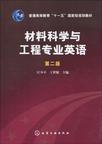材料科学与工程专业英语
出版时间:2010-1 出版社:化学工业出版社 作者:匡少平,王世颖 主编 页数:249
前言
出版系列的专业英语教材,是许多院校多年来共同的愿望。在高等教育面向21世纪的改革中,学生的基本素质、知识面及实际工作能力的培养受到空前重视,其中专业英语水平是衡量大学生素质能力的重要指标之一。在此背景下,教育部多次组织会议研究加强外语教学问题,制定有关规范,使外语教学更加受到重视。教材是教学的基本要素之一,与基础英语相比,专业英语教学的教材问题显得尤为突出。 国家主管部门的重视和广大院校的呼吁引起了化学工业出版社的关注,他们及时地与原化工部教育主管部门和全国化工类专业教学指导委员会请示协商后,组织全国十余所院校成立了大学英语专业阅读教材编委会。在经过必要的调研后,根据学校需求,编委会优先从各校教学(交流)讲义中确定选题,同时组织力量开展编审工作。本套教材涉及的专业主要包括:化学工程与工艺、石油化工、机械工程、信息工程、工业过程自动化、应用化学、生物工程、环境工程、精细化工及制药工程、材料科学与工程、化工商贸等。 《材料科学与工程专业英语》教材第一版于2003年2月由化学工业出版社出版。2002年9月交稿时,其中包括的课文与阅读材料均选自1999~2002年的原版英文教材、科技报告、著作及专业期刊。现6年多过去了,在材料科学与工程方面出现很多创新理论与技术,因此,有必要将有关新的知识体系对原教材进行更新和完善。2009年6月,该教材第二版被确认为普通高等教育“十一五”国家级规划教材出版。为此,我们吸收第一版时的出版经验,对教材第二版中的内容进行了重新设计,所有课文和阅读材料均选自2006~2009年出版的原版英文教科书、科技报告、著作及专业期刊等,并增加了相关的阅读练习。 教材特点:根据国家“十一五”教材出版规划,按照“全国部分高校化工类及相关专业大学英语专业阅读教材编审委员会”的要求和安排编写的《材料科学与工程专业英语》教材,具有以下特点:(1)知识面宽:该书囊括了目前与材料科学相关专业的各类知识,金属材料、陶瓷材料、聚合物材料、复合材料、纳米结构材料及生物材料等内容,覆盖范围宽,学科全面;(2)内容新颖:教材读物均选自国外最新出版的相关学科教材、专著或期刊论文,内容新颖,学科前沿知识丰富,学生和教师都可从中了解材料科学的最新发展趋势;(3)趣味性强:教材读物在保证学科知识基础性、全面性的前提下,有相当一部分具有很强的趣味性。我们在材料科学类专业英语的教学过程中发现,学生对学科专业以外的知识;如教材中生物材料和纳米材料的功能、应用及其制备表现出极大的兴趣,这样有利于学生拓宽知识面、开阔视野;(4)读者面宽:《材料科学与工程专业英语》教材适用于各类材料专业的学生使用。
内容概要
《材料科学与工程专业英语》为普通高等教育“十一五”国家级规划教材,是根据《大学英语教学大纲》专业阅读部分的要求编写的。全书共分七部分,共24个单元,每个单元由一篇课文和一篇阅读材料组成。阅读材料提供与课文相应的背景知识或是课文的续篇;根据课文与阅读材料的内容,配有相应的练习题、注释和词汇表。课文与阅读材料共计48篇,均选自2006~2009年出版的原版英文教科书、科技报告、著作及专业期刊等。其中,第Ⅰ部分为材料科学与工程概论,主要介绍材料科学与工程的历史、材料的分类、材料的特性、材料与化学的关系,以及材料科学的研究进展和发展趋势;第Ⅱ~Ⅶ部分,分别介绍金属材料(包括合金)、陶瓷材料、聚合物材料、复合材料、纳米结构材料和生物医学材料的化学组成、性质、种类、制造技术和用途等。 本教材内容丰富、新颖,知识面宽,趣味性强;适应于各类材料专业的学生使用,也可作为研究生、教师及相关领域研究人员的学习参考书。
书籍目录
Part ⅠINTRODUCTION TO MATERIALS SCIENCE AND ENGINEERING Unit 1 Materials Science and Engineering Unit 2 Classification of Materials Unit 3 Atomic Structure of Materials Unit 4 Physical and Chemical Properties of Materials Unit 5 Mechanical Properties of Materials Unit 6 Looking Beyond the Last 50 Years:The Future of Materials Science and EngineeringPart ⅡMETALLIC MATERIALS AND ALLOYS Unit 7 Introduction to Metals and Alloys Unit 8 Superalloy Unit 9 Corrosion of Metallic MaterialsPart ⅢCERAMICS Unit 10 Introduction to Ceramic Materials Unit 11 Relationship among Microstructure,Processing,and Applications Unit 12 Bioceramics(Part Ⅰ)Part ⅣPOLYMER Unit 13 Introduction to Polymer Unit 14 Soft Materials:Polymers and Plastics Unit 15 Biodegradable Polymers for Food PackagingPart ⅤCOMPOSITES Unit 16 Introduction to Composites Unit 17 Properties of Composite Materials Unit 18 Polymer Nanotechnology: NanocompositesPART ⅥNANOSTRUCTURED MATERIALS Unit 19 Nanotechnology and Nanostructured Materials Unit 20 Creation of Nanostructured Materials Unit 21 Applications of Nanostructured MaterialsPART ⅦBIOMATERIALS Unit 22 Biomaterial: An Introduction Unit 23 Applications of Biocomposites Unit 24 Biocompatible Dental MaterialsAPPENDIXES AppendMain Journals of materials Science and TechnologyAnswer to Reading ComprehensionGLOSSORY
章节摘录
Sustainable development is the level of human activity that can meet the needs of thepresent without compromising the ability of future generations to meet their ownneeds.Present world C02 emissions are quite alarming.The ozone-depleting chlorofluorocar-bon(CFC)consumption is also quite serious.The United States and European Union haveaddressed the ozone depletion issue with government policies and strict enforcement;Chinaand Brazil have yet to rise to the occasion. The outlook is optimistic,especially when we see initiatives to reduce greenhouse gasemissions in the United States as well as certain European nations(e.g.,Finland).In theUnited States。a tenth of venture capital is invested in clean energy.The Economist estimatedthat the total investment going into clean energy in 2006 was$63 billion(versus$49 bil-lion in 2005,and$30 billion in 2004).Nanosolar Inc.,based in California,hopes to signifi-cantly cut the cost of producing solar panels.Nanosolar uses new non-silicon semiconductormaterials with the absorber being two orders of magnitude thinner than that of silicon wafercells.Tekes,the National Technology Agency of Finland,has announced targets for increa-ses in total consumption of renewable energy of 40 9,6 by the year 2025. The global demand for energy is growing at alarming rates,and the demand from developingcountries will further exacerbate the situation.The current energy utilization worldwide is about 14terawatts,and bv the end of the 21st century,it may reach 50 terawatts.There has to be a shift to renewable energv sources from fossil fuels,which today supply about 80%of the world’s energy.Earth-based renewable sources of energy(i.e.,hydroelectricity,wind,geothermal,bio-mass,etc.)will not be sufficient to meet the energy consumption needs of the world.Solar power will certainly be an important resourc~We will see future material developments in nanostructured materials,advanced photovoltaic materials such as nanocrystalline silicon thin films and novel chal-cogenides,advanced catalysts with more accessible surface area,nanostructured catalyst supports,and membranes.Light-emitting diodes with enhanced quantum efficiency for lighting devices will al-so play an important role. The hydrogen economy has the potential to enable us to provide for our future energy needs from renewable energy sources.However,we need to be able to develop efficient cata-lytic electrolytic processes to convert water to hydrogen using sunlight.Hydrogen storage is another serious issue,and advanced materials will be developed to safely store hydrogen and also to have the ability to release the hydrogen when needed.Nanostructured materials and novel hydrides will play an important role in these endeavors.Lastly,we will see many ad~vances in fuel cells,which utilize hydrogen to convert chemical energy to electrical energy and have the advantage of generating power quietly and without harmful emissions;the chal~lenge will be for fuel cells to have high sustainable energy densities.We wil see maj or devel~opments in solid-oxide fueI cells。molten carbonate fuel cells,polymer electrolyte membrane ruel cells。and phosphoric acid fuel cells.
图书封面
评论、评分、阅读与下载
用户评论 (总计28条)
- 材料专业的专业英语介绍,很不错
- 此书不好,建议金属材料专业的学生不要买,我**了。。。
- 很实用 别忘了学英语 每天学
- 很专业 有用
- 教材课本,支持正版
- 书蛮好,内容不错,老师推荐……
- 不错吧要是有全文翻译就好了。
- 书拿到了,还行,就是没有全文翻译。。。书还没读呢,估计还可以把。。。
- 书挺好的,现在的满额减活动很给力。。
- 书好着,不错
- 书很新,是正版的
- 书很好 略贵
- SSSS
- 送货速度了得啊!
- 这个商品不错,质量很好很赞
- 推荐买奶粉甜蜜他人付款不付款同一家
- 跟学校发的一样,应该是正版。
- 书不错,选来作为材料专业的本科生教材的
- 专业书,质量还可以,就是封面有点灰尘
- 感觉内容一般!
- 如果课文有中文注释就好了
- 还行吧!有一本书中间是白板
- 挺适合我们看的!
- 材料物理专业用的
- 知识点不够突出,有点像科技英语阅读理解训练,作为教材好像缺少必要的知识点提炼。
- 因为我们这么科目是新开的,我们届就当白老鼠了!老师完全没有讲过里面的内容。。。。
- 如果单词有音标就好了,书本身有些损伤
- 书的质量怎样先不说,发货速度跟物流无力吐槽,2.24号付款,3.3号货到本地,3.5号拿到
